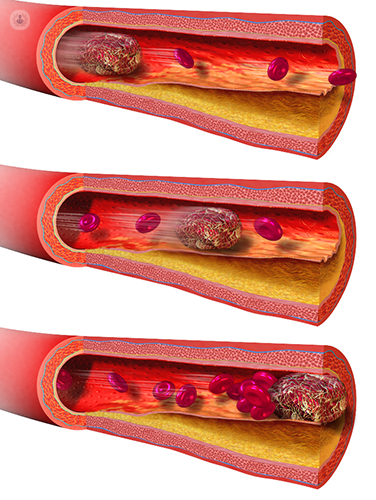

What is an embolism?
An embolism is the blockage of an artery by either an air bubble or blood clot which can affect the part of the body as ischemia occurs in the area of the affected blood vessel.
There are several clinical forms of embolism: the cerebral, in which the obstruction affects a brain vessel and results in a severe stroke; pulmonary embolism in which the pulmonary artery gets blocked causing a loss of function of part of the lung, or in severe cases death; embolism of the central artery of the retina, which can lead to blindness of the affected eye.

What are the symptoms of an embolism?
The symptoms of an embolism depend on the type of embolism. The main result of a cerebral embolism is a stroke, for which the symptoms are:
- Weakness and numbness in one side of the body
- Drooping of one half of the face
- Slurred speech
Symptoms of a pulmonary embolism are:
- Stabbing pain in the chest
- Shortness of breath
- Faintness
- Passing out
What causes an embolism?
An embolism is caused by a foreign body blocking an artery. Blood clots can cause embolisms as when they move through an artery, if it gets stuck and it blocks the blood flow to part of the body. Deep vein thrombosis (DVT) is a blood clot in the deep veins of the legs which is one of the most common causes of a pulmonary embolism. Air bubbles when they enter the bloodstream can block an artery as well, which is something that scuba divers have to be aware of as returning to the surface from a dive too fast can cause decompression sickness (also known as ‘the bends’). Fat can also cause an embolism, for example, if someone fractures a bone fat particles from the bone can move into the bloodstream, causing a blockage. Cholesterol is also a concern for embolisms as if cholesterol that has narrowed an artery breaks off and moves into the bloodstream, this can cause a blockage.
Can an embolism be prevented?
It is possible to prevent an embolism by identifying potential causes of blood clots and reduce your risk.
Many of these measures are related to lifestyle choices:
- Being a healthy weight – obesity is a risk factor for blood clots forming.
- Stop smoking
- Exercising regularly
- Eating a healthy diet
- Reducing salt intake
How are embolisms treated?
The objectives of treating embolisms are to control the symptoms and improve the flow of blood to the affected area. Anti-coagulant medication can be used to help make the blood thinner to prevent further clots forming. Surgery is also a treatment option in which a procedure called an embolectomy removes the obstruction by making an incision in the artery so that the blocked can be sucked out (this is called aspiration).
